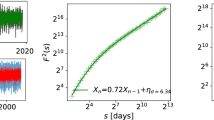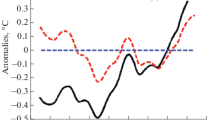Abstract
The issue of whether the secular climate (twentieth century) is stationary or changing to some new semi-permanent state is clouded by the presence of so-called ‘climate fluctuations’. The twentieth century climate record of the United States reveals a substantial number of decadal fluctuations which occur in all seasons for both temperature and precipitation. Recent examples of such behavior include changes in winter and summer temperature variability and increases in transition season precipitation. Statistical evidence suggests that a substantial portion of these fluctuations, even those which are remarkably unusual, are merely manifestations of a stochastic process which possesses weak year-to-year persistence as viewed from an a posteriori perspective. The implications of this result are particularly important with respect to the formulation of physical causes of the fluctuations. The results emphasize the desirability of well-founded clearly-stated a priori theories of climate change as well as the limited usefulness of widely used climate normals.
Similar content being viewed by others
References
Changnon, S. A. Jr.: 1987, ‘An Assessment of Climate Change, Water Resources, and Policy Research’, Water International 12, 69–76.
Court, A.: 1967–68, ‘Climatic Normals as Predictions: Parts I–V’. Sci. Rep. Air force Cambridge Research Lab., Bedford, MA, Contract AF19 (628)-5176 (NTIS AD-657 358, AD-686 163, AD-672 268, AD-687 137, AD-687 138).
Craddock, J. M.: 1981, ‘Monitoring a Changing Climate Series’, J. Climatology 1, 333–343.
Diaz, H. F.: 1986, ‘An Analysis of Twentieth Century Climate Fluctuations in Northern North America’, J. Clim. Appl. Meteor. 25, 1625–1657.
Douglas, A. V., Cayan, D. R., and Namias, J.: 1982, ‘Large-scale Changes in North Pacific and North American Weather Patterns in Recent Decades’. Mon. Wea.Rev. 110, 1851–1862.
Ellsaesser, H. W., MacCracken, M. C., Walton, J. J., Grotch, S. L.: 1986, ‘Global Climatic Trends as Revealed by the Recorded Data’, Rev. of Geophys. 24, 745–792.
Epstein, E. S.: 1982, ‘Detecting Climate Change’, J. Clim. Appl. Meteor. 21, 1172–1182.
Box, G. E. P. and Jenkins, G. M.: 1976, Time Series Analysis: Forecasting and Control, Holden-Day, San Francisco, CA, 575 pp.
Gates, W. L. and MacCracken, M. C.: 1985, ‘The Challenge of Detecting Climate Change by Increasing Carbon Dioxide’, M. C. MacCracken and F. M. Luther (eds.), Detecting the Climatic Effects of Increasing Carbon Dioxide, U.S. Dept. of Energy, DOE/ER-0235, Washington, D. C. 20545, 1–12.
Gilliland, R. L. and Schneider, S. H.: 1984, ‘Volcanic, CO2 and Solar Forcings of Northern and Southern Hemisphere Surface Air Temperature’, Nature 310, 38–41.
Hansen, J., Johnson, D., Lacis, A., Lebedeff, S., Lee, P., Rind, D., and Russell, G.: 1981, ‘Climatic Impact of Increasing Atmospheric Carbon Dioxide’, Science 213, 957–966.
Harvey, A. C.: 1981, Time Series Models, Phillip Allen Publ., 222 pp.
Hurst, H. E.: 1957, ‘A Suggested Statistical Model of Some Time Series Which Occur in Nature’, Nature 180, 494.
Karl, T. R., Livezey, R. E., Epstein, E. S.: 1984, ‘Recent Unusual Mean Winter Temperatures Across the Contiguous United States’, Bull. Amer. Meteor. Soc. 65, 1302–1309.
Karl, T. R. and Riebsame, W. E.: 1984, ‘The Identification of 10- to 20-Year Temperature and Precipitation Fluctuations in the Contiguous United States’, J. Clim. Appl. Meteor. 23, 950–966.
Karl, T. R., Williams, C. N. Jr., Young, P. J., Wendland, W.: 1986, ‘A Model to Estimate the Time of Observation Bias Associated with Monthly Mean Maximum, Minimum, and Mean Temperatures for the United States’, J. Clim. Appl. Meteor. 25, 145–160.
Karl, T. R., Young, P. J., 1986: ‘Recent Heavy Precipitation in the Vicinity of the Great Salt Lake: Just How Unusual?’ J. Clim. Appl. Meteor. 25, 353–363.
Kates, R. W.: 1980, ‘Climate and Society: Lessons Learned from Recent Events’, Weather 35, 17–25.
Katz, R. W.: 1982, ‘Statistical Evaluation of Climate Experiments with General Circulation Models: A Parametric Time Series Modeling Approach’, J. Atmos. Sci. 39, 1446–1455.
Kay, P. A. and Diaz, H. F. (eds.): 1985, ‘Problems and Prospects for Predicting Great Salt Lake Levels’, Center for Public Affairs and Administration, University of Utah, May, 1985, 309 pp.
Klein, W. H.: 1983, ‘Objective Specification of Monthly Mean Surface Temperature from 700 mb Heights in Winter’, Mon. Wea. Rev. 111, 674–691.
Lamb, H. H., Johnson, A. I.: 1961, ‘Climatic Variation and Observed Changes in the General Circulation’, Geogr. Ann. 41, 363–400.
Lamb, P. J. and Changnon, S. A. Jr.: 1981, ‘On the ‘Best’ Temperature and Precipitation Normals: The Illinois Situation’, J. Appl. Meteor. 20, 1383.
Lorenz, E. N.: 1963, ‘The Mechanics of Vacillation’, J. Atmos. Sci. 20, 448–464.
Lorenz, E. N.: 1984, ‘Formulation of a Low Order Model of a Moist General Circulation’, J. Atmos. Sci. 41, 1933–1945.
Lorenz, E. N.: 1986, ‘The Index Cycle is Alive and Well’, Namias Symposium, Lib. Cong. #86-50752, 188–196.
Madden, R. A. and Ramanathan, V.: 1980, Science 209, 763–768.
Mandelbrot, B. B. and Van Ness, J. W.: 1968, ‘Fractional Brownian Motions, Fractional Noises and Applications’, SIAM Rev. 4, 422–437.
Mandelbrot, B. B. and Wallis, J. R.:1969a, ‘Computer Experiments with Fractional Gaussian Noises, 1, Averages and Variances; 2, Rescaled Ranges and Spectra; 3, Mathematical Appenix’, Wate Resour. Res. 5, 222–267.
Mandelbrot, B. B. and Wallis, J. R.: 1969b, ‘Some Long-run Properties of Geophysical Records’, Water Resour. Res. 5, 321–340.
McCleary, R. and Hay, R. A. Jr.: 1980, Applied Time Series Analysis For the Social Sciences, Sage Publication 331 pp.
Mitchell, J. M. Jr.: 1976, ‘On Overview of Climate Variability and its Casual Mechanisms’, Quaternary Research 6, 481–493.
Mitchell, J. M. Jr., Dzerdzeevskii, B., Flohn, H., Hofmyer, W. L., Lamb, H. H., Kao, K. N., and Wallen, C. C.: 1966, ‘Climatic Change Technical Note 79, World Meteorological Organization’, WMO-No. 195, T.P. 100, Geneva, Switzerland, 79 pp.
Namias, J., 1978: ‘Multiple Causes of the North American Abnormal Winter of 1976–77’, Mon. Wea. Rev. 106, 279–259.
Namias, J.: 1978, ‘Persistence of U.S. Seasonal Temperatures up to One Year’, Mon. Wea. Rev. 106, 121–131.
O'Connell, P. E.: 1971, ‘A Single Stochastic Modeling of Hurst's Law’, in Proceedings of the International Symposium on Mathematical Mode in Hydrology, International Association of Scientific Hydrology, Warsaw, pp. 327–358.
Panofsky, H. A., Brie, G. W, Some Applications of Statistics to Meteorology, Penn. State Univ. (1968) (See Appendix III).
Priestly, M. B.: 1981, Spectral Analysis and Time Series, Academic Press, 890 pp.
Quinn, F. H.: 1986, ‘Causes and Consequences of the Record High 1985 Great Lakes Water Levels’, Amer. Meteor. Soc. Conf. on Climate and Water Management, Asheville, NC 281–290.
Rasmusson, E. M., Wallace, J. M.: 1983, Science 222, 1195–1201.
Rodriguez-Iturbe, I., Mejia, J. M., and Dawdy, D. R.: 1972, ‘Streamflow Simulation, 1, A New Look at Markovian Models, Fractional Gaussian Noise and Crossing Theory; 2, The Broken Line Process as a Potential Model for Hydrological Simulation’, Water Resour. Res. 8, 921–941.
Sabin, T. E. and Shulman, M. D.: 1985, ‘A Statistical Evaluation of the Efficiency of the Climate Normal as a Predictor’, J. Climatology 5, 63–77.
Schwarz, G.: 1978, ‘Estimating the Dimension of a Model’, Am. Statist. 6, 461–464.
Thompson, L. M.: 1975, ‘Weather Variability, Climatic Change, and Grain Production’, Science 188, 535–541.
van Loon, H., Williams, J.: 1976, ‘The Connection between Trends of Mean Temperature and Circulation at the Surface. Post I: Winter’. Mon. Wea. Rev. 104, 1003–1011.
Walsh, J. E., Tucek, D. R., and Peterson, M. R.: 1982, ‘Seasonal Snow Cover and Short-term Climate Fluctuations over the United States’, Mon. Wea. Rev. 110, 272–286.
Warrick, R. A.: 1980, ‘Drought in the Great Plains: A Case Study of Research on Climate and Society in the U.S.A.’, in Ausubel, J. and Biswas, A. K. (eds.) Climatic Constraints and Human Activities, 93–124. Pergamon, NY.
Author information
Authors and Affiliations
Rights and permissions
About this article
Cite this article
Karl, T.R. Multi-year fluctuations of temperature and precipitation: The gray area of climate change. Climatic Change 12, 179–197 (1988). https://doi.org/10.1007/BF00138938
Received:
Revised:
Issue Date:
DOI: https://doi.org/10.1007/BF00138938




